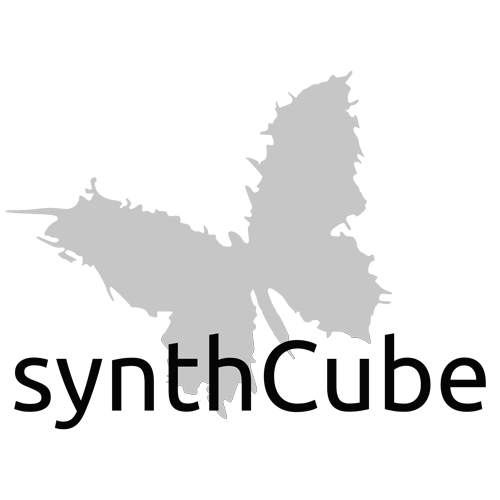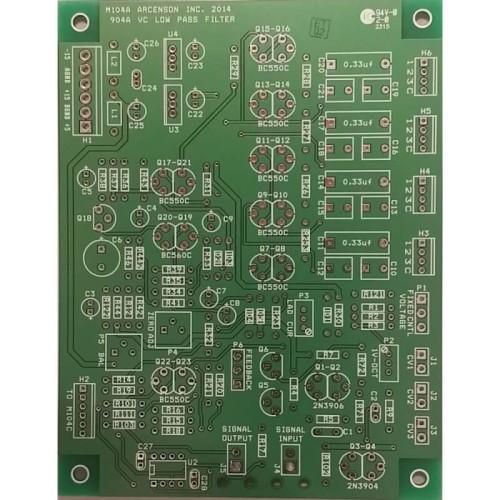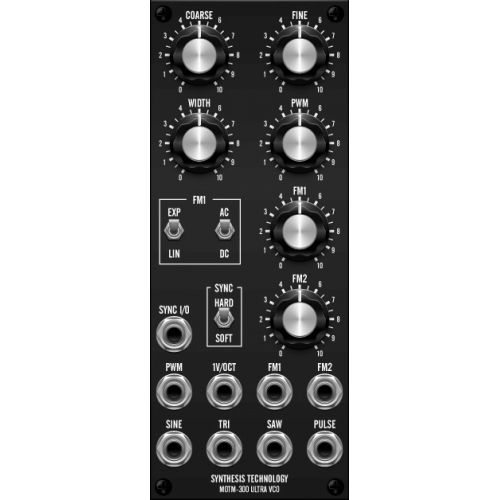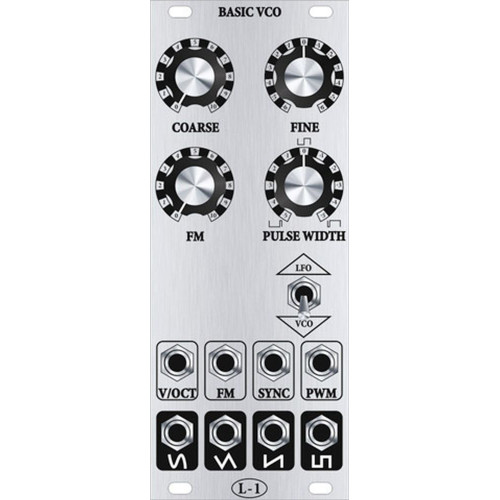Synthasystem Quad VCO
a classic analog synth design re-imagined for new euro synth users!
the steiner synthasystem is back
the first module we've released is the quad vco.
the circuit was faithfully redeveloped by david ingebretsen in 2011 with permission and consultation from Nyle Steiner; euro panel design by clarke robinson 24hp
the pcb set includes the main pcb, hf trimmer pcb, and power pcb (3 pcb set)
“This module produces an oscillating signal whose frequency is based on a voltage input. Typically, this is an audible tone, but this module can oscillate from well below hearing to well above. The control voltage input is typically tuned to a 1 volt/octave scale. Four waveforms are available, Sine, Triangle, Sawtooth, and Pulse. These four outputs are available at the same time. This module has a very wide useable frequency range from well below audible as a Low Frequency Oscillator to above hearing without re-tuning. Nyle really outdid himself on this module.
the module is 3" (76mm) deep, and includes 2 attenuated output jacks for each of the four wave patterns -- sine, saw, triangle and square (pulse)
three cv ins provide fine control over the frequency range; the rightmost jack (cv3) is calibrated to the 1v/octave standard
cv control for pulse width is provided as well as a phase reset (synch) jack.
the module has a number of trimmers on the PCB for extra fine control of wave shapes, offsets, pulse width, frequency range, HF tracking etc.
Nyle named this module a Voltage Controlled Function Generator. I think that is a fair and accurate name. It’s also a voltage Controlled Oscillator.
This module produces an oscillating signal whose frequency is based on a voltage input. Typically, this is an audible tone, but this module can oscillate from well below hearing to well above. The control voltage input is typically tuned to a 1 volt/octave scale. Four waveforms are available, Sine, Triangle, Sawtooth, and Pulse. These four outputs are available at the same time. This module has a very wide useable frequency range from well below audible as a Low Frequency Oscillator to above hearing without re-tuning. Nyle really outdid himself on this module. Very unique and I will say I think it has the best sine wave I’ve heard.
From the Synthasystem manual (note some of the details don’t apply to the re-issue module):
Each voltage controlled oscillator (V.C.O.) is identical except for the number of available waveforms that each produces. To avoid repetition we will describe the operation of the type A oscillator shown above, which produces all four waveforms. each waveform is available at two parallel output jacks and each waveform and each waveform has a separate amplitude level pot. Example: Sine wave amplitude is controlled with control knob #2 (Figure #11) and is fed to two output jacks in parallel. Likewise for the triangle, sawtooth and pulse waveforms produced by this oscillator. The pulse waveform has an additional control for pulse width and an additional input jack for controlling pulse width. either of these can control the width of the pulse coming out the output jacks. With the pulse width all the way CCW, and no input at the PWM jack, the pulse waveform is symmetrical and thus a square wave.
The frequency (or pitch) is controlled with the Frequency adjust knob from less than 1/10 Hz (cycles per second) to greater than 20KHz and can be fine adjusted with the Fine Frequency knob. Frequency is also controlled by feeding control voltages in the VC input jacks. Frequency modulation is accomplished by feeding an A.C. signal (such as the output from an oscillator) into one of these jacks instead of a D.C. voltage.
Each oscillator has an input jack called phase reset. Any signal with a fast negative going edge, for example a sawtooth, square wave, or pulse, will reset the output waveform to a precise point whenever the negative edge occurs as shown in figure #11A. usually the input signal at jack is lower in frequency than the oscillator, and the oscillator tends to take on a pitch sensation of the lower frequency with the timbre changing as the osc frequency is varied. This also makes it possible to have one oscillator track at a harmonic of another with no beating whatsoever.
Here are the figures:
USE:
Inputs/Outputs:
This module has three fundamental inputs and four outputs:
- VC Inputs – These inputs accept a voltage input, typically between 0 and 10 volts. This can come from any source which provides a voltage output. VC3 Var Scale is an input which can be configured to respond to a different scale than the 1 volt/octave scale of the other two inputs.
- VC Width – This input accepts a voltage which dynamically changes the width of the pulse on the Pulse Output.
- Phase Reset – this input accepts a falling edge to reset the phase, or sync, the VCO output frequency to that of the signal at this input. A signal with a steep trailing edge works best, such as a pulse or a “ramp” type sawtooth wave.
- Waveform Outputs – The top row of jacks provide the waveform outputs according to the legend on the panel.
| Module Parameters | |
| Format | Eurorack |








